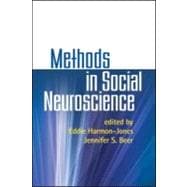Straightforward and practical, this is the first book to provide detailed guidance for using neurobiological methods in the study of human social behavior, personality, and affect. Each chapter clearly introduces the method at hand, provides examples of the method's applications, discusses its strengths and limitations, and reviews concrete experimental design considerations. Written by acknowledged experts, chapters cover neuroimaging techniques, genetic measurement, hormonal methods, lesion studies, startle eyeblink responses, facial electromyography, autonomic nervous system responses, and modeling based on neural networks.








